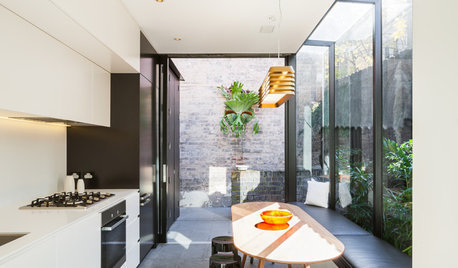Which herbs die back, and which green up?
leira
15 years ago
Related Stories

KITCHEN DESIGN12 Great Kitchen Styles — Which One’s for You?
Sometimes you can be surprised by the kitchen style that really calls to you. The proof is in the pictures
Full Story
MIDCENTURY STYLEWhich ‘Mad Men’ Prop Would You Like for Your House?
Fancy a pair of Don Draper’s office chairs or Peggy’s blue typewriter? Vintage props from the TV show are up for auction
Full Story
KITCHEN DESIGNOpen vs. Closed Kitchens — Which Style Works Best for You?
Get the kitchen layout that's right for you with this advice from 3 experts
Full Story
DECORATING GUIDESWhich Rooms Get the Oscar?
On the eve of Hollywood’s night of nights, we bring you top films from the past year and their interior twins
Full Story
KITCHEN DESIGNHouzz Quiz: Which Kitchen Backsplash Material Is Right for You?
With so many options available, see if we can help you narrow down the selection
Full Story
FURNITUREWhich Dining Table Shape Should You Choose?
Rectangular, oval, round or square: Here are ways to choose your dining table shape (or make the most of the one you already have)
Full Story
FUN HOUZZHouzz Quiz: Which Midcentury Modern Chair Are You?
Have a seat for a little fun. Better yet, have a seat that has you written all over it
Full Story
KITCHEN SINKSWhich Faucet Goes With a Farmhouse Sink?
A variety of faucet styles work with the classic farmhouse sink. Here’s how to find the right one for your kitchen
Full Story
REMODELING GUIDESWhich Window for Your World?
The view and fresh air from your windows make a huge impact on the experience of being in your house
Full Story
DECORATING GUIDESWhich Wallcovering Is Right for You?
Transform a Space With a Wall of Wood, Paper, Fabric, Maps and More
Full Story









ksrogers
francescod
Related Professionals
Canton Landscape Architects & Landscape Designers · Elwood Landscape Architects & Landscape Designers · Erie Landscape Architects & Landscape Designers · Hershey Landscape Architects & Landscape Designers · Rossville Landscape Architects & Landscape Designers · Winder Landscape Architects & Landscape Designers · Centereach Landscape Contractors · Deerfield Beach Landscape Contractors · Fort Atkinson Landscape Contractors · Fort Hunt Landscape Contractors · Fuquay-Varina Landscape Contractors · Newberg Landscape Contractors · Vacaville Landscape Contractors · Shafter Landscape Contractors · Blue Island Roofing & GuttersleiraOriginal Author
flora_uk
Daisyduckworth
francescod
leiraOriginal Author